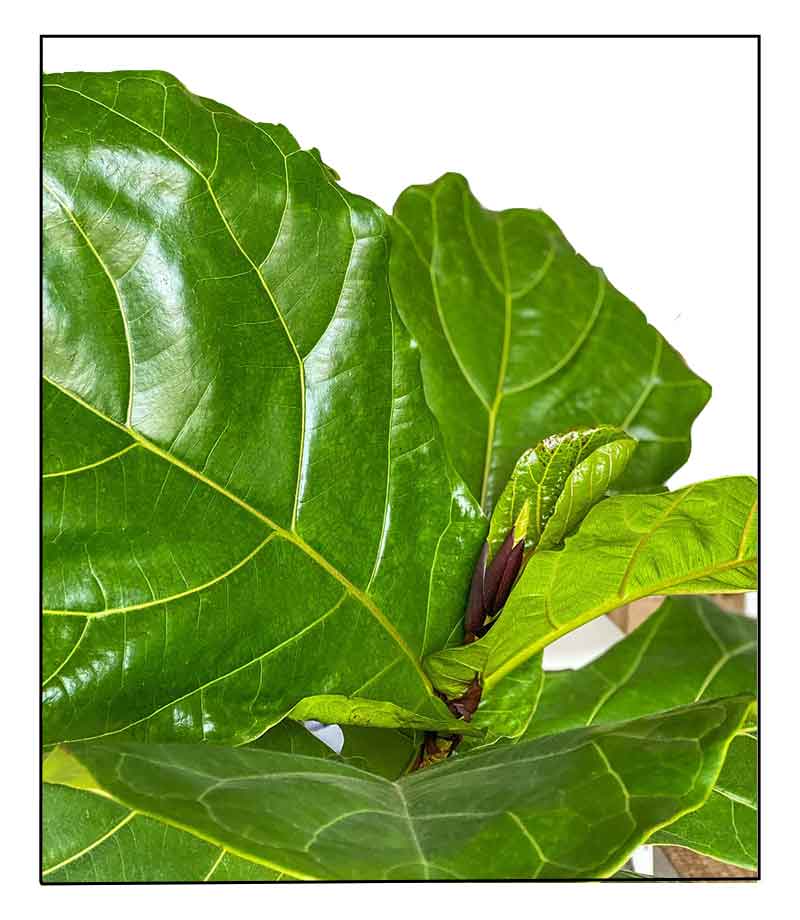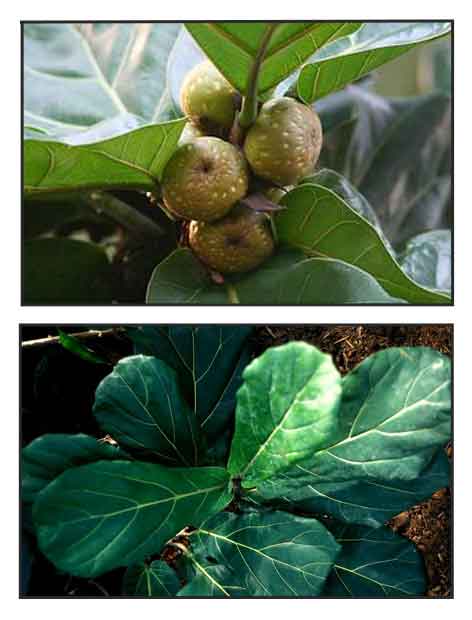 Gen info Gen info
- Etymology:The' genus name Ficus is Latin for Fig and the Fig tree. The word comes from the ancient Greek 'oukov', The species epithet is Latin for lyre, the homonymous musical instrument.
- The species name is attributable to the shape of the leaves of the plant, as well as the lyra, the dorsal and abdominal fin of the piper gumard. (10)
- In the wild, the tree lives more than 50-70 years; while in captivity as an indoor plant, it lives for 25-50 years. (10)
Botany
Ficus lyrata is a large tree growing up to 12-15 m (30-49 ft) tall. Leaves are variable in shape, but often with a broad apex and narrow middle, resembling a lyre or fiddle; up to 45 cm (18 in) long) long and 30 cm (12 in) broad, though usually smaller, with a leathery texture, prominent veins, and a wavy margin. The fruit is a green fig, 2.5-3 cm (1- 1 1/4 in) diameter. (2)
Ficus lyrata is a large tree, up to 12 m tall with many tuberculous and glamorous young shoots. Leaves with stout, glabrous, grooved petiole 2-5 cm long, laimina thick fiddle-shaped or pabdurate, 15-30 cm long, costate at the cordate base, sinuate-entire, almost truncate, and shortly acuminate at the apex, glabrous lateral nerves 4-5 pairs; stipules narrowly triangular-lanceolate, 4-5 cm long, acuminate, glabrous, persistent. Hypanthodia sessile, in axillary pairs, globose, 2.5-6.5 cm in diameter, finely puberulous. Male flowers with 2-3 sepals, ovate-lanceolate, stamen solitary with ovoid anther. Female flowers with 3 sepals, ovate, obtuse; style short with papillate stigma. (Flora of Pakistan, 2014) (1)
 Species may begin as an epiphyte, developing some aerial roots and growing to become a moderate to large-sized banyan tree, up to 12 m, usually smaller in temperate climates. (Starr et al, 2003) (1) Species may begin as an epiphyte, developing some aerial roots and growing to become a moderate to large-sized banyan tree, up to 12 m, usually smaller in temperate climates. (Starr et al, 2003) (1)
Leaves can grow 30 inches long and 12 inches wide, leathery and dark green.
Distribution
- Introduced.
- Cultivated as ornamental: as a shade tree, outdoor house plant, or indoor potted plant. (1)
- Native to Africa.
- Introduced to Asia (Indonesia, Pakistan, Singapore),
Europe, North and South America.
 Constituents Constituents
- GC-MS analysis of latex yielded alkaloids, flavonoids, phenols, tannins, and terpenoid. (see study below) (5)
- Study of dried fruit extract yielded phenolic compounds, flavonoids, and tannins. GC analysis revealed catechin, luuteolin-6-8-C-diglukoside and orientin. (see study below) (6)
-
UPLC-qTOF-MS-based metabolomic study of 72 metabolites from leaves and fruits characterized 17 flavonoids with main constituents of catechins/procyanidins, O- and C-linked flavonoid glycosides. Major procyanidins were dimers and trimers comprising (epi)catechin and (epi) afzelechin units, whereas predominant flavones were C-glycosides or luteolin and apigenin. Benzoic acids, caffeoylquinic acids, fatty acid and sphingolipids were also annotated. (7)
Properties
- Toxicity and allergenicity: Ficus lyrata is not toxic to humans and pets unless they come in contact with the milky sap, which can cause skin irritation or a rash. People with a history of asthma may develop allergic reactions when the sap gets airborne on dust particles spreading throughout the house or office. (10)
-
Studies have suggested antioxidant, antibacterial, anti-candidal, preservative properties.
Parts used
Leaves, fruit, latex.
Uses
Edibility
- As an indoor plant, the fiddle leaf does not bear fruit. Grown outdoors, the fruit it bears is no edible. (8)
Folkloric
- No recorded folkloric medicinal use in the Philippines.
Others
- Ornamental: Cultivated as an ornamental, shade tree or potted plant.
- Ritual: Used in some magic rituals (fetish tree)/ (1)
- Environmental: Boundary, barrier. or support. (1)
Studies
• Antibacterial: Study evaluated the antibacterial potential of aqueous and ethanol extracts and two pure compounds ursolic acid (FL1) and acacetin-7-Oneohesperidoside (FL-2) isolated from Ficus lyrata. against several standard bacterial strains. Results showed potential antibacterial activity against P. aeruginosa, S. aureus, S. dysenteriae, S. boydii, C. freundii, P. vulgaris, P mirabilis. The aqueous extract showed more potent activity. The antibacterial activity could possibly be attributed to the two pure compounds. (3)
• Antimicrobial / Leaves: The antimicrobial potential of leaves was attributed to the presence of components such as polyphenols, tannin and triterpenoid. Study compared the antimicrobial activity of fresh and encapsulation leaf extract against two bacteria i.e., Escherichia coli and Bacillus subtilis. Fresh leaf extract showed inhibition zone of 6.66 and 4.33 against Bs and Ec respectively, while encapsulated extract showed 2.03 and 3.44 against Bs and Ec, respectively. (4)
• Anti-Candida Activity / Latex: Study evaluated the antimicrobial activity of ethyl acetate latex extract of F. lyrata and Nystatin on clinical isolates of Candida albicans from vulvovaginal candidiasis and standard strain of C. albicans ATCC 5027. Results showed the extract has inhibitory effect on clinical isolates and type strain in lower concentrations than Nystatin with diameter of inhibition zones ranging from 22 to 26 mm and 30 to 32 mm, respectively. (see constituents above) (5)
• Fruit Extract as Natural Preservative / Antioxidant / Antibacterial: Study evaluated ethyl acetate dried fruit extract of F. lyrata as biopreservative to chicken carcass. DPPH and clear zone analysis of the extract showed high antioxidant and antibacterial activity. Acute toxicity study showed an LD50 below 15000 mg/kg suggesting non-toxic material. Application of the extract to the carcass showed inhibition of chicken decay for 2 hours. Results suggest the fruit extract has potential as natural preservative to extend shelf life of fresh chicken carcasses. (see constituents above) (6)
• Antioxidant / Leaves: Study evaluated the antioxidant potential of eight Ficus species, including Ficus lyrata by DPPH and FRAP methods. Methanolic extract of leaves from Ficus elasticoides showed highest radical scavenging activity with 96.69% DPPH inhibition, followed by extracts of F. lyrata at 94.53% with IC50 of 9.3 µg/ml, close to ascorbic acid (8.00 µg/ml) and gallic acid (8.20 µg/ml). Ferric reducing power of F. lyrata (185.01 µM) was the strongest. (11)
Availability
Cultivated.
|

![]()






